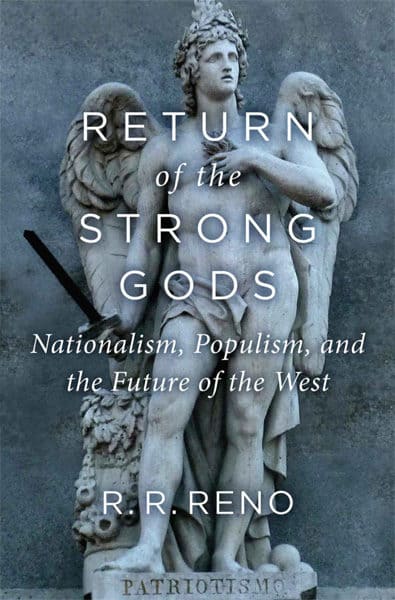The Worldview We Need
Gregory Hood, American Renaissance, September 15, 2020
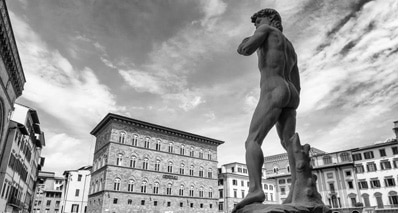
American race relations are in permanent crisis. Every encounter between police and a black suspect, or even between white and black citizens, can spark a riot. This isn’t surprising. Blacks benefit from rioting; it brings support from the federal government and big corporations. Both the state and corporate America should be enemies of anarcho-communists, but they support radicals and anti-capitalists.
There’s a similar permanent crisis within the American conservative movement. Despite its rich non-profits and platform access, “the movement” is still mouthing the slogans from the Reagan years. In 2015–2016, Donald Trump openly defied not just the “GOP Establishment,” but the American conservative movement, and we can identify key institutions and people that define the American conservative movement. These include National Review the American Enterprise Institute, and commentators such as Ben Shapiro, David French, and Erick Erickson. They probably thought the movement’s tradition of “purges” would stop Trump. They were wrong.
President Trump has governed like a traditional American conservative, despite his nationalist rhetoric, so most Never Trumpers have made peace with him. However, the key lesson from the 2016 campaign was that the conservative movement, the supposed leaders, had lost touch with their base. This will still be the case after President Trump is gone, whether in November or four years from now.
Many Republican voters do not want unregulated capitalism, tax cuts, free trade, and more foreign wars. They don’t want cuts to Medicare or Social Security. Many Midwestern working-class voters in traditionally Democratic states switched from Barack Obama to Donald Trump. This was surely a rejection of free trade and globalism. Some data suggest it was also because of race, specifically white resistance to cultural change. Whatever the case, I can say with confidence it wasn’t because voters in Michigan, Pennsylvania, and Wisconsin were poring over Heritage Foundation policy papers. While the American conservative movement has reconciled itself to defending President Trump personally, the larger question of what American conservatism is remains. What Conservatism, Inc. preaches is not what many Republican voters want.

Click here for a larger version.
The American Conservative, founded to question neoconservative foreign policy and the Iraq War, recently asked what the next American conservatism should look like. The Conservative Partnership Institute’s Rachel Bovard suggested that though America faces new challenges, “free enterprise, voluntary association, and the United States Constitution are still Americans’ best chance of success.” William Ruger of the Charles Koch Institute championed a new “fusionism” between classical liberalism, social conservatism, and localism. He revealingly concluded that we should “have faith in our uniquely American brand of conservatism and have faith in America.”
Political movements have to have “faith.” There must be faith in victory. However, “faith” isn’t practical guidance, especially if we are asked to have “faith” in old documents and legal formulas. The Constitution lays out the way our government is supposed to work. It’s a rule book. However, leftists (and many on the Right) have been ignoring the rules for decades. In The Age of Entitlement: America Since the Sixties, Christopher Caldwell argues that the Constitution has been replaced by a “rival constitution, with which the original one was frequently incompatible — and the incompatibility would worsen as the civil rights regime was built out.”
Joe Sobran made similar arguments, noting that the Constitution set out specific, limited powers for the federal government. Nonetheless, the federal government kept expanding into our daily lives. The Civil Rights Act of 1964 badly limited freedom of association. “Civil rights advocates” like those at the Southern Poverty Law Center and the Anti-Defamation League fight free speech rather than defend it. If current demographic trends continue, what’s left of the First Amendment may be abolished within this century.
Conservatives seem to sense what is coming; hence the warnings that a President Joe Biden would mean tyranny or the end of the American way of life. Unfortunately, conservatives lack an effective ideology. “Democrats are the real racists” and “the Founders favored equality” are historically illiterate arguments. Defending “free enterprise” is hardly compelling when Big Tech — private companies — censors conservatives, and when the U.S. Chamber of Commerce backs Democrats. The conservative temptation is to retreat to the Constitution and “classical liberalism.” Forever on the defensive, the American conservative movement gives its frustrated followers clever arguments why they can’t talk about certain things and shouldn’t use state power to accomplish their goals. Power may corrupt; powerlessness corrupts too.
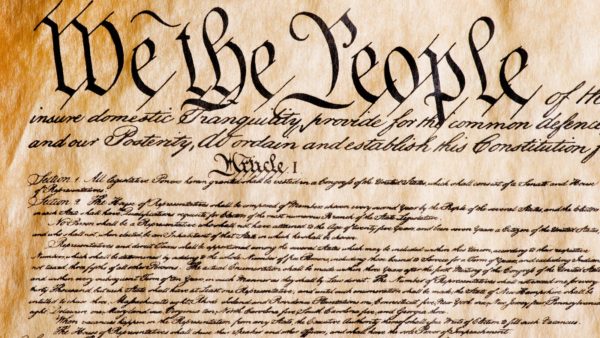
We can’t rely on the Constitution to save us. It has already failed to prevent a massive federal bureaucracy and unelected judges from imposing policy. For example, today California is a deep blue state. However, Californians voted against mass immigration when they passed Proposition 187 in 1994. A court threw it out. On the most important issue, the people’s will didn’t matter. Now it’s too late to save the Golden State. Falling back on legalism is the sign of a failing movement. The side in politics that is more concerned with “means” than “ends” is the side that’s losing.
Classical liberalism is hardly more compelling than appealing to a long-dead Constitution. Joe Sobran joked that when someone proclaims new “human rights,” no one exclaims, “Oh good, I’m getting more rights!” “Human rights” are the justification for government intervention in our lives, especially to protect “marginalized groups.” That leaves the individual at the mercy of organized groups with a collective identity and a claim to victimhood.
Under “disparate impact” legal doctrine, practically any policy can become a potential civil rights violation if it leads to racial discrepancies. The races don’t perform equally in all fields, so discrepancies are inevitable. If you assume inherent racial equality, you must fall back on Critical Race Theory and white privilege to explain non-white failure. Indeed, the federal government teaches Critical Race Theory under the “nationalist” Trump Administration. The administration isn’t funding American Renaissance, but it paid Robin DiAngelo thousands.
We may even need to revisit the Founders’ assumptions. The philosophical underpinnings of classical liberalism are false. Man is not a blank slate; our genetic makeup helps shape our personality, values, and even political attitudes. Racial differences in intelligence are so undeniable that the most famous opponent of race realism, Stephen Jay Gould, resorted to fraud. Most people do not make rational judgments. Instead, they interpret information to support their biases. Control over information, which is in Big Tech’s hands, means the power to shift public opinion. It undercuts the whole concept of self-government.

(Credit Image: © Jan A. Nicolas/DPA via ZUMA Press)
America is not a Jeffersonian Republic of small farmers and shopkeepers. It has sharp income inequality. The middle class — the traditional bastion of any national populist movement — is squeezed between hostile oligarchs and the resentful, non-white underclass the oligarchs imported for cheap labor. This is the “Top-Bottom” alliance against the Middle, as COVID-19 lockdowns and BLM riots destroy small businesses. Today, the law is not a neutral arbitrator that protects property. Instead, America’s government is an “anarcho-tyranny” that cracks down on certain groups while ignoring the crimes of others.
American conservatism didn’t conserve classical liberalism. No one could. Classical liberalism arose from a specific social and political environment. We no longer live in a homogeneous white country in which only property-owning men vote, and in which the population shares a Christian moral background (if not Christian belief). To “return” to classical liberalism would require “returning” to that society. Liberalism, classical or otherwise, is dead. Today, we are seeing the logical conclusions of this flawed system. What will replace it? Who can overthrow its last vestiges?
Some conservative intellectuals, especially Roman Catholics, understand that classical liberalism is failing. Patrick Deenan’s Why Liberalism Failed started this debate within Conservatism Inc. Sohrab Ahmari and Adrian Vermeule have also called for a politics of the common good or integralism with a heavily Catholic emphasis. R.R. Reno’s Return of the Strong Gods urged a resurrection of “strong gods” such as virtue, patriotism, and common religiosity. None of this is surprising; the most important “Counter-Enlightenment” philosopher was the great Catholic reactionary Joseph de Maistre.
Of course, the problem is that like so many conservatives, Traditionalist Catholics are trying to save an institution that is already corrupted. In 2017, the Vatican publication La Civilta Cattolica denounced an alliance between “Evangelical Fundamentalism and Catholic Integralism” as an “Ecumenism of Hate.” Traditionalist Catholics also have nothing useful to say about race. R.R. Reno called white identity “perverse.” Sohrab Ahmari doesn’t have any practical suggestions about opposing the thin conservatism offered by people like David French. The Catholic publication The Crisis wrote an especially nasty smear against Sam Francis. At least one Catholic church is offering prayers against “white privilege.” I don’t question the wisdom or courage of Catholic Identitarians such as Julien Langella, but they must reconquer the Church before they can reconquer the West. This isn’t the Church of Francisco Franco or Éamon de Valera, let alone Pope Urban II.
The larger American conservative movement failed because it has largely avoided talking about power. It wished power away, pretending it didn’t exist. Power and hierarchy always exist, and man’s limitless desire for power shapes elite decisions. We must understand the way power functions in the real world. Power isn’t something to be avoided, but a necessary tool. Modernism, which views politics from a temporal, desacralized, rationalist perspective, allows us to analyze it. Unfortunately, Modernism has also unleashed social liberalism and eaten through traditional America like acid.
Does it have to be this way? Evolutionary science shows us that universal racial equality is a myth. Scientific rationalism is paradoxically showing us that man is not a purely rational animal. What’s more, BLM hysteria suggests that when God is removed from the public square, new gods takes His place. In our society, multiculturalism is a faith, complete with sacred sites of pilgrimage and martyrs. One could even argue it has miracles. The “experts” assured us that mass protests won’t spread COVID-19 but that going to the store will. “Are Protests Dangerous? What Experts Say May Depend on Who’s Protesting What,” was the title of a New York Times article.
Sam Francis didn’t think Modernism was necessarily a weakness. He argued that James Burnham offered the theoretical key for rightists to dynamite the foundations of the liberal order. In a little known monograph (still available on Amazon, so get it while you can), “The Other Side of Modernism: James Burnham and His Legacy,” Francis wrote that Burnham’s thought was “distinctly modernist.” Burnham “harbored no illusion that a particular form of society . . . could adequately restrain the appetite for power.” However, this doesn’t mean that modernism itself must be attacked. Instead, it could be used. “Among contemporary conservatives,” wrote Francis, “only James Burnham offered a theoretical framework and a practical application of modernist political ideas that challenge the conventional modernist categories as defined by the Left.”
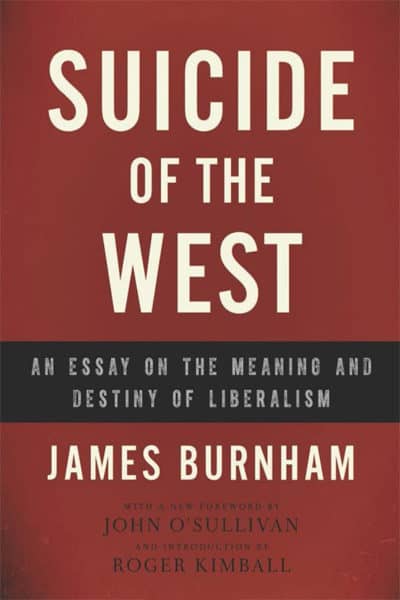
Burnham’s work challenged American conservatives’ assumptions as well. He focused on order and power, which alienated libertarians. He dismissed supernatural claims as meaningless. He argued that tradition, ideology, and even art spring from “irrational and mythic forces,” as does the basis for authority. Ideology and myth usually are just the masks power wears.
Christian traditionalists may not like their belief being called a “myth” or analyzed as temporal phenomena rather than the Will of God. However, though Burnham’s thought was modernist, even anti-moderns such as Joseph de Maistre would agree with some of it. For example, de Maistre argued that monarchy was an enduring form of government precisely because it is irrational and “men never respect what they have made.”
This argument is especially important when we analyze the conflicting attitudes towards the Constitution by American conservatives and progressives. Conservatives, desperate to defend what’s left of the Old Republic, think the Constitution is semi-sacred. Meanwhile, leftists dismiss the Constitution as an outdated document written by “dead white men” who have little relevance today.
Ideas mean nothing if there isn’t a revolutionary class to champion them and turn them into political action. Francis thought he found such a class in his famous “Middle American Radicals” (MARs). These are the white working-class voters who are suspicious of radical egalitarianism and economic neoliberalism. The MARs were the backbone of Patrick Buchanan’s and Ross Perot’s insurgent campaigns, and President Trump’s 2016 campaign. They are swing voters or they don’t vote at all. They are unlikely to be persuaded by appeals to the Constitution or the glories of the free market. However, American conservatives, aside from President Trump, can’t communicate with them.

April 10, 2019 – Crosby, TX – President Donald Trump President meets with students and union members. (Credit Image: © Joyce Boghosian via ZUMA Wire)
American conservatives naïvely keep trying to fulfill the Left’s moral dictates about “equality” and “anti-racism,” even though it never gets them anywhere. The values-neutral state of the liberal imagination has never existed and can never exist. What conservatives fail to realize is that these slogans were always just a way to take power. Marxists and rightist intellectuals such as Carl Schmitt were both right in their own way. The state always serves the interests of certain groups. The question is which group is in power. We should be cynical about political rhetoric. We should always look to the concrete ends the rhetoric serves, rather than just the formal meaning of the words.
However, though we must start with cynicism, we can’t end there. Cynicism doesn’t inspire. Most leftists in the streets today really do believe in their egalitarian ideal, even if it’s impossible. Perhaps people have a psychological need for an impossible goal. In Francis’s short piece, he quotes Whittaker Chambers, a convert from communism to Catholicism. Chambers argued that modernists often miss essential truths by reducing everything to material terms. In Chambers’s striking phrase, “The Fire Bird is glimpsed living or not at all.”
Men need a myth, something that reaches beyond empirical judgments about what is “true” or “false.” There’s a yearning for “life beyond life,” in Evola’s phrase. He argued that power and action need a religious or supernatural justification; otherwise they are largely wasted. The calculating, individualist Economic Man can’t see beyond his own interests — so men look elsewhere for meaning. American conservatives and libertarians shouldn’t be surprised that Amazon, Nike, and other corporations are more hostile to Donald Trump than to self-proclaimed socialists. On an individual level, it’s almost always “rational” to conform and avoid trouble, but a truly fulfilling life, for individuals and peoples, must embrace struggle and an impossible goal. You can’t have that without a moral vision.
How can we encourage people to act romantically, idealistically, and “irrationally?” The Right’s central value is hierarchy, which implies order, authority, and service to something higher than oneself, whether that’s God, the state, or an Ideal. The Left’s central value is equality, which implies disorder, change, and the destruction of existing systems. A healthy society needs both impulses, because a purely Rightist society would be static and cut off from the masses, and a purely Leftist society would be in a constant, permanent revolution. The Leftist spirit of entropy has too much power today. However, we also have great income inequality, and ordinary Americans are practically powerless. It’s hard to discuss this because modern leftists think fighting racism and “hate” is more important than fighting inequality. They believe they are fighting the System even though they are the System. Thus, Michelle Obama can say with a straight face that white America ignores black women. Meanwhile, we are supposed to believe white men addicted to opioids and killing themselves are “privileged.”

The solution is nationalism, which synthesizes both Right and Left into something greater. We pursue the greatness of the nation and the well-being of the community. We recognize natural inequality between and among peoples, but we demand service from those with greater power and ability — what we used to call noblesse oblige. The proper attitude is that of Frederick the Great, who, though King, considered himself “First Servant of the State.” Thomas Jefferson said there would always be a “natural aristocracy,” but it must constantly prove its legitimacy.
Healthy men are not islands. Giuseppe Mazzini, in The Duties of Man, said that everyone owes a duty to humanity, but workers must “conquer a Country for yourselves” before they can hope to accomplish anything: “Do not be led astray by the idea of improving your material conditions without first solving the national question.”
But who belongs to our nation? We can thank our foes for telling us.

Writing on the “friend-enemy” distinction that defines politics, Carl Schmitt wrote that actual participants in the struggle are “in a position to judge whether the adversary intends to negate his opponent’s way of life and therefore must be repulsed or fought in order to preserve one’s own form of existence.” Whether its “decolonizing” campaigns in art or mathematics, tearing down statues, or defending looting, Black Lives Matter and its leftist allies are showing us that they want to erase our identity and the civilization created by whites. This effort is taking place across the Western world.
- Protesters pulled down a statue of Canada’s first Prime Minister, John A. Macdonald.
- Black Lives Matter marches have started in France.
- A “decolonization” effort in Australia demands special privileges for Aborigines.
- There is a “decolonization” movement in Germany, which means Europeans living in their ancient homeland are still somehow “colonizers.”
- In Washington D.C., a committee has called for sweeping name changes in our capital city, including renaming institutions named after Thomas Jefferson, James Monroe, and Francis Scott Key.
The issue is race. It is what defines “us” and “them.” Conservatives refuse to grapple with this truth, but they are not the ones in power. Those with power see as us white. Like the reluctant patriots among the Founding Fathers, we must recognize our foes have imposed an identity on us and we are rebels, whether we like it or not.
The truth is that we are one people. We share one struggle. This may seem a typically American response to others in the Western diaspora, especially those in Europe. However, we must understand that our identity is at least partially forced on us. To paraphrase Sam Francis, our foes hate us not because “we are ‘Westeners’ or ‘Americans’ or ‘Christians’ or ‘conservatives’ or ‘liberals,’ but because we are white.”
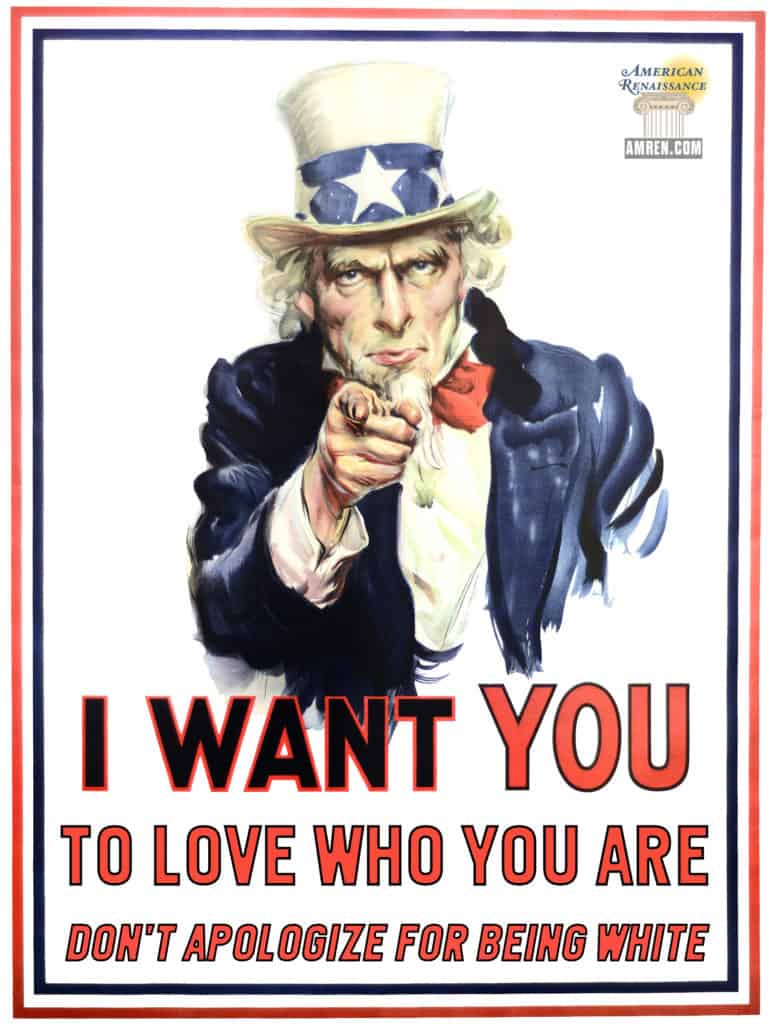
I’d add something to that. “Whiteness” isn’t just a biological reality. “Whiteness” is partially a social construct, but it’s the leftists who control media, academia, and foundations who have defined it. “Whiteness” also refers to behavior and values that lead men to pursue a certain vision that is higher, nobler, and better than themselves. The Smithsonian African-American History Museum recently said “whiteness” involves “hard work,” “delayed gratification,” and proper grammar. It’s not just a campaign against white people. It’s also a campaign against the Western form of human greatness, whether expressed in the thoroughly modern program of space exploration or the pre-modern majesty of Notre Dame cathedral.
Saul Alinsky wrote that the activist requires a certain amount of doublethink to avoid becoming a true believer. He must believe with all his heart in equality, but at the same time prevent his ideology from leading him to stupid decisions. While Alinsky is hardly a role model, he has a point. We can’t follow the American conservative model of simply repeating cliches about limited government or the Constitution. We can’t assume America is somehow exempt from the laws of history. Through the work of James Burnham and Sam Francis, we can understand the way power functions in our society and the critical role the egalitarian myth has in justifying the status quo. At the same time, we should already be looking forward to what comes after this System, when we are once again free to be ourselves.
Our ideal is a united white, Western Civilization that can collectively secure our people’s destiny. We require a “civilization-state.” This requires replacing the current “Western” world order, which undermines our culture and tradition. Most “Western” governments today act against their white constituents’ interests, rather than defend them.
Whites share one fate, wherever our legal citizenship may lie. The conflict is imposed on us whether we want it or not. This is the Identitarian Century, and the great questions of the future will not be settled by appeals to parchment or sentimentality. They will be settled by those who can view politics realistically but still demand the impossible. It will be won if we can reconcile Evola and Burnham, Francis and Faye.

